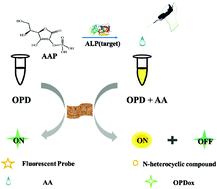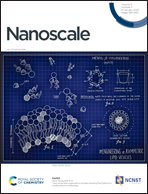Ratiometric sensing of alkaline phosphatase based on the catalytical activity from Mn–Fe layered double hydroxide nanosheets†
Abstract
Two-dimensional (2D) Mn–Fe layered double hydroxide (LDH) nanosheets are firstly examined to mediate an O-phenylenediamine (OPD) based fluorescent switch in the presence of ascorbic acid (AA). On one hand, Mn–Fe LDH mimicked the functions of oxidase to catalyze the oxidation of OPD to OPDox, emitting fluorescence at 565 nm. On the other hand, Mn–Fe LDH acts as a superior catalyst for the reaction between AA and OPD to generate 3-(1,2-dihydroxyethyl)furo[3,4-b]quinoxalin-1(3H)-one (N-heterocyclic compound) with an emergence of the maximum emission at 425 nm (ca. 6 fold). The presence of AA not only induces the enhanced emission at 425 nm from the N-heterocyclic compound, but also leads to decreased fluorescence at 565 nm due to the decomposition of Mn–Fe LDH nanosheets. On the basis of the reversed fluorescence response at 425 and 565 nm, ratiometric fluorescence sensing methods (ΔF425 nm/ΔF565 nm) are developed for the determination of AA. With the assistance of alkaline phosphatase (ALP), the activity of ALP can be monitored using the ratiometric platform based on the hydrolyzing ascorbic acid 2-phosphate to yield AA with the detection limit of 0.16 mU mL−1. Different from the traditional ratiometric sensing platform, where two fluorescent probes are often introduced, the present ratiometric system derived from one signal precursor holds great potential in developing a facile platform and broadens the application of 2D nanomaterials in the field of biology.



 Please wait while we load your content...
Please wait while we load your content...